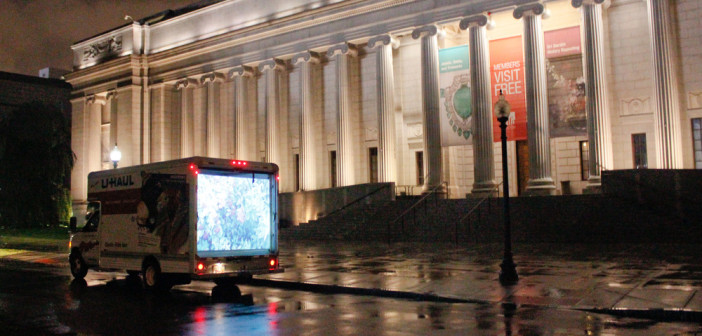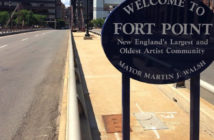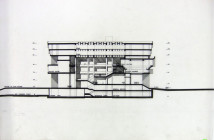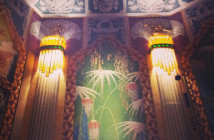Part of Olmsted’s Emerald Necklace, the Arnold Arboretum is one of the interconnected parks that links many of Boston’s cultural institutions and neighborhoods. Butler’s video was shown in eleven locations around Boston including the city of Cambridge, Somerville and Brookline.
Unable to meet the truck in its first stop in Jamaica Plain by public transit, I traveled to Mission Hill in Roxbury to experience the work in a relatively quiet setting. As the truck pulled into a dark, unpaved alley on Alleghany Street, it started to rain. Besides Kiermaier and Butler, in the audience were three people, a couple and me.
Unable to immerse myself in the work given the short length of time the truck stops (7-10 minutes), I headed to Chinatown to see it animate the dark alleys of this vibrant, but rapidly fading neighborhood of Boston. At Chinatown, the crowd was larger—around ten people, but they all appeared to know each other.
There was only one problem and it wasn’t the work, but rather the execution of the event. I could never do the work or the artist any justice if I simply wrote about it without fully immersing myself in it. The length of time the truck stopped at each location was too short to appreciate it, let alone to engage with the audience.
Kiermaier, is quoted as saying in the Boston Globe that “part of [the allure]is not letting people in on the where and when until practically the last minute.” There is no allure when those who could benefit the most--the members of the community in which the truck is parked in, aren’t there to experience it.
The idea of activating the often neglected, abandoned or under-utilized spaces in a city, excites me just as much as the idea of exposing as many people to as much art as possible. But when people don’t know where a pop-up exhibit is taking place, it defeats the purpose of engaging with an audience outside the white cube. No one is engaged unless they are present to see it. Those who were engaged are part of the Boston art world bubble.
From my perspective as an audience member the project failed to create "an enriching cross cultural and multi-generational dialogue," unlike the one-night video installation of Daniel Phillips’ River Street, part of the 2011 Boston Cyberarts Festival.
The organizers of the River Street installation reached out to the communities of Dorchester and Hyde Park by distributing flyers and engaging in conversations months prior to the event. The end result was a well-attended event. Many of the community members present approached me to say how grateful they were to have been invited to experience the video projection. River Street was successful in engaging people outside the white cube.
My point here is that the potential of a mobile art project like White Walls has yet to be exploited. And for it to make a difference, “and to foster a community that is based on dialogue,” as the Berwick Research Institute’s mission states, it needs to become accessible for those without easy access to the arts. As of this past Summer, it isn't.




